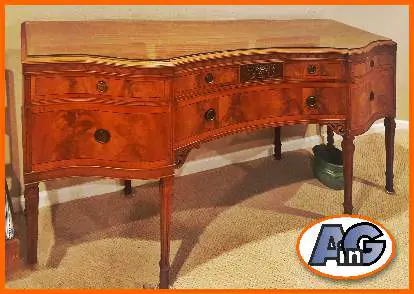Tempered (heat-strengthened) glass is 4 times more impact-resistant than regular annealed glass and is safer because it breaks into harmless “popcorn” fragments. But tempered glass is more expensive than annealed – is it worth the extra cost? Find out if glass tabletops should be tempered in this definitive post.
Patio glass tabletops should always be tempered. Protective glass tabletops may or may not be tempered, & heavy glass tops generally do not need to be tempered.
Table of contents
What is tempered glass?
Modern architectural glass is made by the “float” process invented by the Pilkington Company – a ribbon of molten glass is floated on a bed of molten tin to form a continuous sheet of very flat and uniform glass.
The molten glass is cooled slowly to create the standard flat product – called annealed glass – that is sent to glass companies for further processing. Jump to this section for more details about tempering.
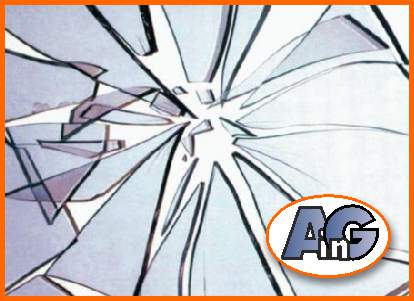
As the image above shows, annealed glass has the disadvantage that, when it breaks, it forms very sharp and dangerous shards that can be life-threatening. For this reason, a process called “tempering” was invented to make glass much more impact-resistant and also much safer when broken:
See the instantaneous shattering of tempered glass in this Artistry in Glass video – where a glass worker strikes the vulnerable corner of the glass with a sharp bradawl.
This deliberately broken tabletop is made for decorative purposes. The 1/4″ thick tempered glass is sandwiched between two sheets of glass that keep the “popcorn” fragments contained (the edges are held in place by a bead of clear silicone).
To decide if your glass tabletop should be tempered let’s first find out about the benefits of tempered glass:
Benefits of tempered glass
Compared with annealed glass, tempered glass is stronger (more impact-resistant), safer, and also heat-resistant. Tempered glass is identical to annealed in appearance, translucence, and hardness but is slightly more (about 12%) expensive.
Strength
Tempered glass is 4 to 5 times more impact resistant than annealed glass.
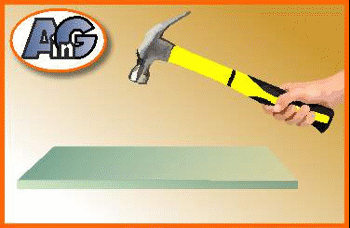
Do not try this at home – but tempered glass is very hard to break, even when struck with a hammer. (caution: do not whack a sharp corner – these are vulnerable!)
Scratch resistance
Tempered glass is slightly more brittle and easier to scratch than annealed glass. For everything you need to know about fixing scratched glass follow this link.
Safety
The breaking characteristic – harmless fragments rather than dangerous shards is a vital advantage for applications like shower and patio doors where building occupants are in close proximity to glass.
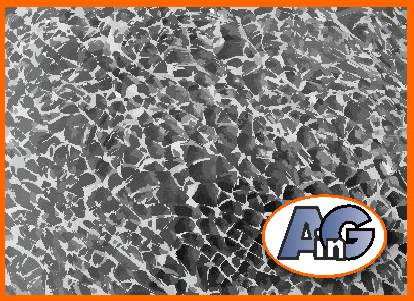
Tempered glass is less likely to chip than annealed glass – for all you need to know about fixing chips in tabletops – follow this post.
Heat-resistance
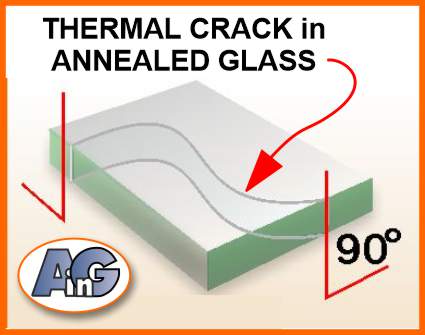
Tempered glass resists thermal stress (uneven heating) – that’s why it is used for stovetop backsplashes and for the windows in ovens. Unlike tempered glass, annealed glass forms distinctive curvilinear stress cracks if it is heated unevenly.
Placing a very hot saucepan directly on your annealed glass top will set up a temperature gradient between hot and room-temperature glass. The internal structure of the glass becomes a battlefield as molecules attempt to accelerate in response to the asymmetrical heating. The result is very interesting, but unrepairable, curved cracks in the glass.
As an Amazon Associate, I earn from qualifying purchases
Should your tabletop be tempered?
The decision to order annealed or tempered glass is very important from the point of view of safety.
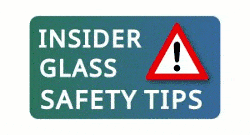
Artistry in Glass cannot be responsible for the consequences of any information given in this post. Broken glass can be life-threatening – always consult a glass professional if you are in any doubt.
The decision to use tempered glass is not always cut and dried. There are a lot of factors involved. The bottom line is summarized below but be sure to read on to learn the full details.
Bottom-line summary:
- Patio glass tabletops (glass used outside the home) should always be tempered.
- Protective glass tabletops (glass on flat wooden tables) may or may not be tempered.
- Heavy glass tops (1/2″ & 3/4″) generally do not need to be tempered.
Detailed advice – to temper or not to temper?
The decision to spend a little more money on tempered glass depends entirely on your concept of risk.
Risk in the glass business
Engineers define risk as the probability of failure multiplied by the consequences

Skydecks and glass bridges are the epitome of high risk in the architectural glass business. Obviously, the consequences of glass failure for occupants of this elevated skydeck are totally catastrophic. The solution is to engineer the deck out of unbreakable, laminated, and tempered glass.
Risk assessment in glass tabletops
Risk in the context of glass tabletops is less catastrophic than a collapsed skydeck but can be no less deadly.
A scary anecdote from Artistry in Glass
Our customer related the dramatic saga of his student son’s activities on one fateful evening at the University of Arizona. This promising but exuberant undergraduate got drunk in his dorm room and danced on top of his glass coffee table. The annealed glass broke and the student was impaled by a shard of glass that entered through his back and punctured his lung. The ashen-faced father, fresh from the emergency department, ordered tempered glass!
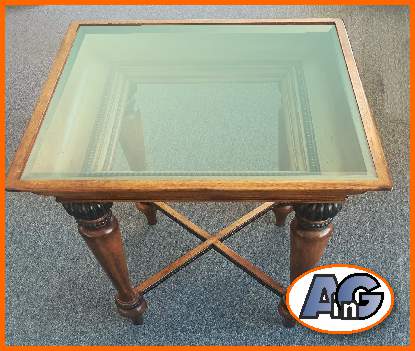
So, although accidents are rare, they can be fatal and great caution is advisable. Read on for an expert analysis of risks – in other words – the likelihood of failure and the consequences of failure.
High-risk – patio tabletops should always be tempered!
Likelihood of failure: patio table glass is generally thin (3/16″) to reduce the weight on flimsy aluminum tables, so it is intrinsically more likely to chip or break unless it is tempered.
It is also the most likely table glass to break because of its vulnerable outdoor location. In high winds, a patio tabletop can act like a sail and go flying onto the concrete floor. Also, inebriated homeowners often forget to remove the umbrella – contributing to wind-related breaking. Finally, kids and teenagers playing games around the pool contribute to the risks.
Consequences of failure: patio glass risks are also rather high because scantily clad homeowners, partying on the patio are likely to be in close proximity to the patio table glass.
Learn all about replacing broken patio tabletops in this post.
In conclusion – be sure to specify tempered glass (often aquatex) when replacing a broken patio table.
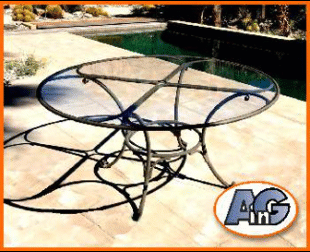
Medium-risk – protective tabletops should sometimes be tempered
Likelihood of failure: a typical 1/4″ thick tabletop resting on a wooden table to protect the surface is very unlikely to get broken in a residential setting, Read all about protective tops in this comprehensive post.
Breakage is most likely to occur by thermal stress: that is when a careless homeowner places a very hot skillet directly on the glass without a placemat or trivet. The other causes are direct impact with a hard object (unlikely in a peaceful household without domestic violence), or breakage while moving the glass for cleaning or a holiday party.
Consequences of failure: protective glass generally presents a rather low risk of personal injury because the broken pieces will likely remain safely on the wooden table top. So the customary advice is to use annealed glass for most tabletops.
Exceptions: nervous homeowners with rambunctious teenagers or cooks who like to place hot saucepans on the glass should choose tempered glass (for the modest extra cost).
A second category of protective glass that needs to be tempered is a desktop with holes and notches for electric cords, or with an irregular shape. Holes, notches, and inside cuts weaken the glass – so stronger tempered glass is recommended.
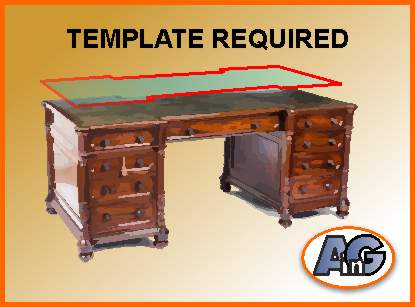
Commercial setting: note that the consequence of failure increases substantially in a commercial setting where your responsibility to customer safety and your insurance liabilities make tempered glass advisable.
Low-risk – heavy tabletops are normally annealed
Heavy (1/2 & 3/4″) thick glass is intrinsically strong so it is very seldom tempered for residential interior use. The glass is so thick that the risk of breakage is very low. However, be aware that it is possible to chip the edge or scratch the surface of heavy glass and these defects are very hard to fix – so take care.
Exceptions: intermediate thickness (3/8″) glass is also not normally tempered but should be if it is in a risky position in your house. All heavy glass should be tempered if it is used on a patio over a tiled or concrete floor – breakage, although unlikely, would be very dangerous.
Commercial: heavy glass in commercial settings, restaurants, bars, and retail shops should be tempered because of your potential liability to customers.
Special exceptions – imported tabletops
Heavy (1/2″ and 3/4″) glass is generally tempered when it is manufactured overseas and shipped to the US (for example from China).
This 36″ round clear tempered glass tabletop is 3/4″ thick with a beautiful flat polished edge. This is the same quality as US-manufactured glass at about 1/2 the price. (Make sure the shipping is free).
All about glass tempering
Annealed glass is tempered (heat-strengthened) in special ovens at the modern glass factory. Glass is cut to the required size and then passed through an oven that heats it to about 1,165 Fahrenheit (630 degrees C) then rapidly cools the surface to produce a “frozen” skin.
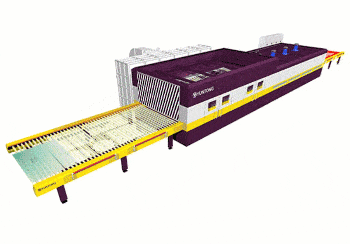
The glass is then cooled slowly so that the, still fluid, center of the glass contracts gradually and pulls inwards producing compression in the frozen skin.
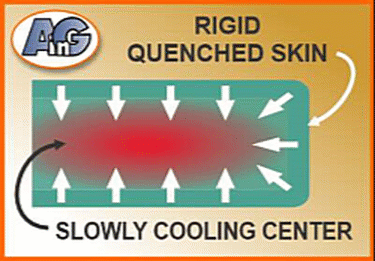
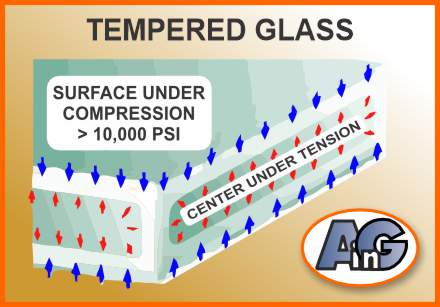
Once tempered, glass cannot be cut, drilled, or ground: breaking the surface skin will result in catastrophic failure (breaking into popcorn fragments).
Follow this link to find out how to tell if glass has been tempered and other interesting facts.
In conclusion: should glass tabletops be tempered?
As you have seen – the answer is “it depends”. Always consider the safety and well-being of your family and get expert advice.
However, the following summary of recommendations is a guide. Always temper patio tables; sometimes temper protective tables, and seldom temper heavy (1/2″ & 3/4″) tables,
Glass safety – learn from the experts!
- Choosing between tempered & laminated glass
- Broken glass injuries and how to avoid them
- Is wired glass safe?
- What is safety glass?
- What is tempered glass?
- What is Gorilla Glass?
- Plexiglass vs glass
- Should glass shelves be tempered?
- Should glass tabletops be tempered?
- Is lead crystal dangerous?
- Is leaded (stained) glass dangerous?
- How to repair cracked stained glass
Glass tabletops & shelves – info from Artistry in Glass
- Benefits of glass shelving – info from experts!
- How much do glass tabletops cost?
- Do glass shelves need to be tempered?
- What is the best thickness for glass shelves?
- Best edge type for glass shelves, polished or beveled?
- How much weight can a wall shelf carry?
- What color glass should my shelves be?
- Glass tabletops – 10 amazing benefits explained
- How to order a glass tabletop
- Best thickness for glass tabletops – expert advice
- Should glass tabletops be tempered?
- Should glass tabletops be beveled?
- How to paint a glass tabletop
- All about tempering glass tabletops!
- How to tell if your glass is tempered
- Can tempered glass be cut?
- How to protect your wood table with glass
- How to fix a scratched glass tabletop
- How to fix a chipped glass tabletop
- How to replace broken patio table glass
- How to measure for a glass tabletop
- Video – how to measure your tabletop
- Plexiglass vs glass – pros and cons
- Beveled glass table base – a case study
- Choosing between tempered & laminated glass
- Glossary of terms used in the glass business

